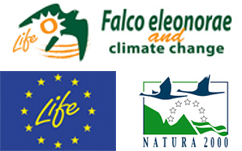Threats
Threats
Deterioration of breeding habitat conditions due to climate change
A decreasing population trend has been observed in colonies located in the southern edge of its distribution in Greece and a subsequent increase in the North Aegean colonies [3]. This shift in the species distribution fits very well with the simulation of the species’ future range under climatic scenarios. The exposure of the nests to sun and wind, as well as the presence of the female parent at the nest is a crucial element during the breeding period, in order to control both the temperature of the incubating eggs and the body temperature of nestlings that are incapable of thermoregularing by themselves at this age. Thus, in view of the overheating effects in the Mediterranean island occurring at the southern limits of the
species breeding range (southern Aegean), the provision of shade and cooling sites on the rocky islets, through establishment of artificial nests is expected to increase the availability of optimal nest sites and, hence, the breeding performance of the species.
Increased pressure from invasive species at its breeding colonies
The presence of human introduced invasive species (rats) on many Aegean islets has been identified as one of the most serious threats for ground nesting birds, especially for seabirds and the Eleonora’s Falcons. During the previous LIFE project LIFE03 NAT/GR/000091, this threat was dealt for the first time is Greece in a pilot scale with eradication campaigns, with very promising results, which was expanded further in the following years through other LIFE projects. Preliminary results from the ongoing LIFE project LIFE10 NAT/GR/000637 indicate that after the recent invasion of rats in a small islet in the central Aegean hosting a colony that has been regularly monitored during the past 8 years, the breeding performance of the species decreased dramatically (>50 decrease of productivity). In a previous assessment it is estimated that 20% of eggs are lost due to rat predation. These figures are alarming, on one hand, because rat predation seems to affect more breeding colonies that what was previously considered, and on the other hand, because such a dramatic decrease could challenge the viability of local populations.
Climate imposed shift in the timing and distribution of passerine autumn migration affects prey availability during the critical brood rearing period for the species
Eleonora’s Falcon is well known for its late breeding period that synchronizes the nestling growth period with the peak of the passerine autumn migration over the Mediterranean. Yet, this relationship is likely to be disturbed since climate change already affects the timing of passerine migration. Such shifts may result in a critical mismatch of the peak passerine passage with the species breeding cycle, seriously affecting the breeding output, as well as the survival of immature birds due to less fat accumulation before departing for their wintering grounds.
Based on the prey analysis conducted during the project LIFE03 NAT/GR/000091, the most frequent prey items in the southern breeding colonies were Phylloscopus trochilus, Saxicola rubetra and Lanius collurio, three species that will be greatly affected by global warming. All three species will suffer a substantial contraction and/or northwards shift of their current breeding range in Europe, which is likely to affect their migratory pattern, both in terms of timing and pathways.
Possible impact of land uses in the species’ foraging grounds
Recent findings on the species’ whereabouts both prior to the beginning and during the breeding period highlight the wealth of habitats the species depends on for feeding and roosting, many of which are influenced by human activities (i.e. arable land, wetlands, forests) far away from the species colonies and up to 50 km from them during the breeding period.
Even more, serious problems have been identified at the tropical rain forests of Madagascar, the main foraging grounds of the species in winter. Following the prescriptions of the Climate atlas of European breeding birds, conservation efforts at the species’ breeding area will not flourish unless “…the wider landscape where a species occurs is rendered more ‘permeable’[…] with the extension across the wider landscape of measures to protect species from the adverse impacts of such factors as persecution or exploitation by humans, or the direct and indirect effects of the use of pesticides and fertilizers.”
Thus, the assessment of foraging habitat use and human pressure on the ecosystems the species’ uses will help identify potential threats and, subsequently, proceed to appropriate mitigation measures.

 Ελληνικά
Ελληνικά English
English